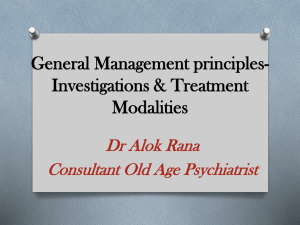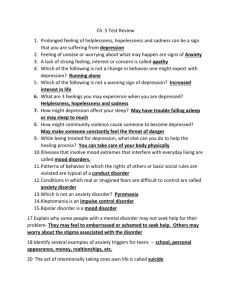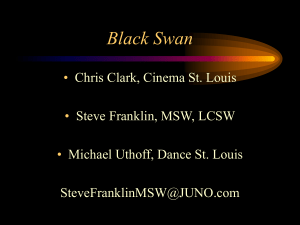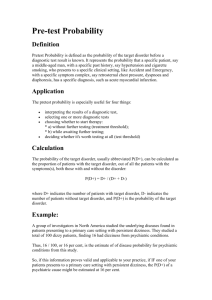Anxiety/panic disorder
advertisement
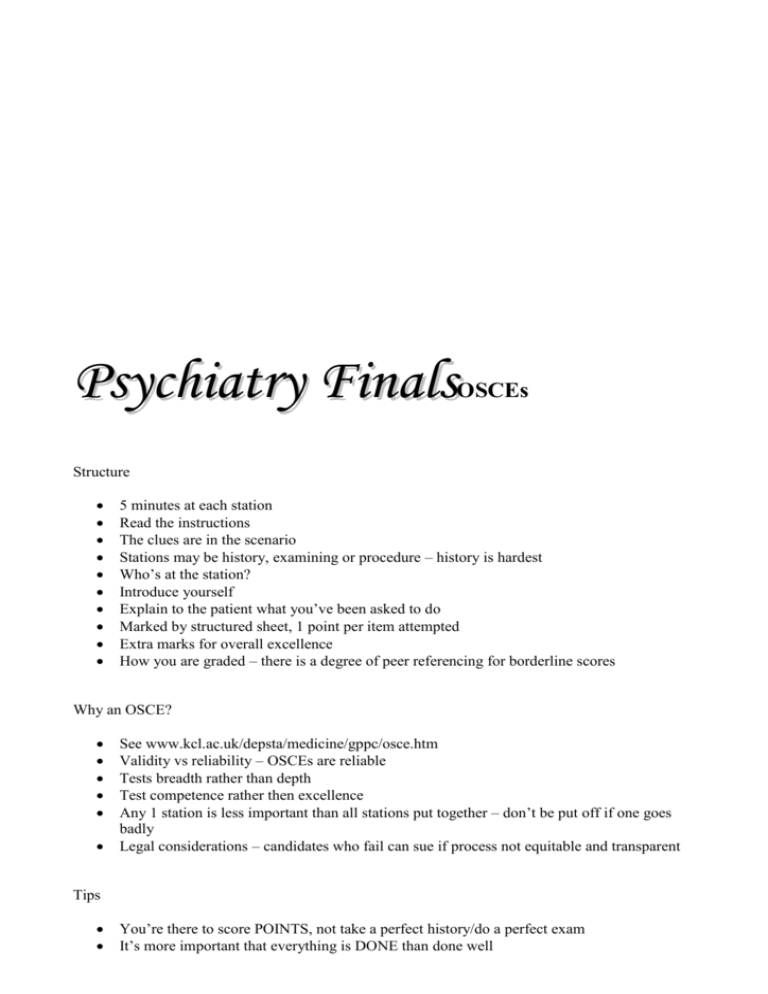
Psychiatry Finals OSCEs Structure 5 minutes at each station Read the instructions The clues are in the scenario Stations may be history, examining or procedure – history is hardest Who’s at the station? Introduce yourself Explain to the patient what you’ve been asked to do Marked by structured sheet, 1 point per item attempted Extra marks for overall excellence How you are graded – there is a degree of peer referencing for borderline scores Why an OSCE? See www.kcl.ac.uk/depsta/medicine/gppc/osce.htm Validity vs reliability – OSCEs are reliable Tests breadth rather than depth Test competence rather then excellence Any 1 station is less important than all stations put together – don’t be put off if one goes badly Legal considerations – candidates who fail can sue if process not equitable and transparent Tips You’re there to score POINTS, not take a perfect history/do a perfect exam It’s more important that everything is DONE than done well Try to appear confident but not arrogant It’s fairer than long cases and short cases! Page 2 of 19 Psychiatric assessment In general, remember that psychiatric assessment is no different than general medical/surgical assessment. Management = assessment + intervention Assessment = history, examination + investigations 1. Personal details 2. Reason for referral 3. History of presenting problem 4. Past psychiatric history 5. Past medical history 6. Drug history 7. Family history 8. Personal history 9. Social history 10. Forensic history 11. Premorbid personality 12. Mental state examination 13. Physical examination InvestigationsPsychiatric assessment Personal details Reason for referral Presenting problem Patient’s own words Symptom clusters Psychosis Mood Anxiety OCD Page 3 of 19 Substance misuse, risk Past psychiatric Diagnoses, admissions, detentions, self-harm, who’s involved Past medical Head injuries Seizures Drug Prescribed OTC + homeopathic Smoking Illicit Alcohol Family Personal Social Forensic Charges past and pending Premorbid personality From others where possible Mental state Use psychiatric terminology Physical InvestigationsMental state examination Appearance Build, distinguishing features, clothing, hygiene Behaviour Agitated/retarded/overactive, eye contact, rapport, appropriateness Mood/affect Subjective Objective – euthymic/depressed/anxious/flattened/blunted/elated/labile, reactivity Speech Rate, rhythm, volume, tone/prosody, coherence Page 4 of 19 Thought form Disorder – loosening of associations, derailment, tangentiality, fusion, overinclusion, concrete thinking, neologism, metonyms, drivelling, verbigeration/word salad May occur in psychosis, autism, learning disability Thought stream Disorder – flight of ideas, circumstantiality, perseveration, echolalia, retardation/inhibition of thought, thought blocking Thought content Delusion* – primary or secondary Self, world, future Risk Perception Illusions, hallucinations^, pseudohallucinations Cognition Orientation, attention, registration/recall, language skills, capacity Insight Are you ill? Mentally ill? Will you accept treatment? Will you accept admission? * Delusion – belief which is abnormal within cultural context (may be true and vary in intensity therefore not fixed false – check level of conviction, preoccupation and distress ^ Hallucination – percept in the absence of corresponding stimulation Page 5 of 19 Glasgow Master List The rest of this handout is in the following format: No. Title Information from Glasgow Master List 1. My top questions to remember to answer during the station – headings to structure your history Specific areas to cover Individual points You’ll find more background info including ICD-10 summaries at www.julyan.co.uk/finals/finals_extended.doc There are also loads of psychiatry OSCEs with marking schedules at www.trickcyclists.col.uk/osces.htm Enjoy! Dr T Everett Julyan March 2006 Page 6 of 19 9. Anxiety/panic disorder Personality disorder Physical cause, e.g. hyperthyroidism Situation-specific, e.g. phobia 1. Is it anxiety? 2. What type? 3. Any other problems? Psychological symptoms Fear of losing control/going crazy/dying, derealisation/depersonalisation Physical symptoms Palpitations, sweating, trembling/shaking, dry mouth, breathing, choking, chest pain, nausea, dizzy, flushes/chills, numbness/tingling Situation Generalised – everywhere/all the time Agoraphobia – crowds, public places, travelling alone/away from home Social phobia – fear of scrutiny by others, e.g. focus of attention, small groups: blushing, shaking, urinary urgency Panic disorder – anxiety attacks, recurrent, unpredictable Panic disorder Symptoms Frequency Other symptoms Avoidance Anticipation Impact on life Restriction General functioning Mood Primary or secondary Coping strategies Alcohol Page 7 of 19 17. Distorted body image Delusional disorder Eating disorders 1. Is it body dysmorphic disorder (dysmorphophobia, a form of hypochondriasis)? 2. Is it anorexia? 3. Is it psychotic? Part of the body affected Reason for concern Size Shape Other Conviction Overvalued idea Delusion Coping Covering up Avoidance Checking Reassurance Plans Surgery Other Associated problems Mood Anxiety OCD Psychosis Suicide Page 8 of 19 27. Acute confusion (history from relative/witness) Any acute illness, e.g. chest infection or heart failure Brain metastases Hypercalcaemia Toxins/drugs 1. Is it delirium or dementia (acute or chronic)? 2. What is the cause? Fluctuating consciousness Illusions, hallucinations Check cognitive function Orientation (time, place) Registration Attention/concentration Naming Repeating Reading Writing Obeying Drawing Recall Think of causes Infection Neoplasia Organ failure Drugs Endocrine/metabolic Trauma Collateral history Page 9 of 19 57. Hearing voices/odd ideas Alcoholic hallucinosis Dementia Depression Hallucinations Psychosis Schizophrenia Puerperal psychosis 1. 2. 3. 4. Is it perceptual (illusion, hallucination or pseudohallucination)? Is it secondary to mood? Is it secondary to drugs/alcohol? Is it a primary psychosis? Hallucinations What Where Who To whom How often How long Reality Distress Coping Content Other perceptual disturbance First rank symptoms Delusions Primary Secondary Mood Depressed Elated Drugs/alcohol Page 10 of 19 61. Hyperactivity Behavioural Drug and food reactions 1. Is it hyperkinetic disorder (ADHD – attention-deficit hyperactivity disorder) Criteria for HKD Abnormal levels of inattention hyperactivity impulsivity In 2 or more situations Onset before age 7 Significant distress or impaired social functioning Not due to Pervasive developmental disorder (autism) Mania Depression Anxiety Page 11 of 19 62. Addiction Alcohol misuse/dependence Other psychiatric diagnoses, e.g. personality disorder or depression Drug misuse/dependence 1. Is it misuse? 2. Is it dependence? 3. What is the risk to self and others, e.g. suicide, forensic? Pattern What When Where Frequency Duration Misuse Harm to physical or mental health At least 1 year Dependence Compulsion Loss of control Withdrawal Tolerance Preoccupation/primacy Persistence despite harm Reinstatement Other substances Effects Physical Mental – mood, suicide Social – job, relationships, forensic Page 12 of 19 63. Obsessions and compulsions Obsessive-compulsive disorder Psychosis, e.g. schizophrenia 1. Are there obsessions or compulsions? 2. Underlying depression, anxiety or psychosis? Obsessions Thoughts, ideas, images, ruminations, doubts Own thoughts Intrusive Recurrent Not pleasurable Resisted Compulsions Subjective sense of pressure to act, e.g. checking, counting, touching, washing, rituals Purposeful Rules Aim is avoidance Magical Depression Psychosis Risk Self Others Page 13 of 19 74. Suicidality Association with physical illness and disability Depression Personality disorder 1. Is it self-harm or suicide? 2. Is there a mood disorder, psychosis or personality disorder? 3. What is the risk? Preparation Intention Planning Note Circumstances Alone Precautions After the act Sought help Remorse Accepted help/treatment Current thoughts/feelings/plans Previous self-harm Mood Psychosis Risk Ideation, intent and plans Medication Social Page 14 of 19 79. Depression Adjustment reaction Depression Personality disorder 1. 2. 3. 4. Mood Is this a depressive disorder? Is this dysthymia? Is this secondary to substance misuse? Is this personality disorder? Diurnal Reactivity Anhedonia Elation Duration >2 weeks (dysthymia >2 years) Biological Sleep (EMW = >2 hours earlier than usual) Appetite Weight loss Energy Fatigue Motivation Concentration Libido Psychological Negative thinking – self, world, future Hopelessness Guilt Delusions Hallucinations Suicidality Substance misuse Personality Page 15 of 19 81. Dementia Alzheimer’s disease Lewy body dementia Vascular dementia 1. Is this dementia or delirium (chronic vs acute)? 2. What type? 3. Is it reversible? Problems Memory Verbal Wandering Social – shopping, cooking, bathing, toileting Cognitive assessment Collateral history Alzheimer’s disease Amnesia, aphasia, agnosia, apraxia Insidious onset Gradual progression Depressed mood, personality change Lewy body dementia Fluctuating course with variation in attention/alertness Visual hallucinations Parkinsonism (rigidity, bradykinesia, festination, mask-like facies > tremor) Falls, hallucinations, systematised delusions, recurrent LOC Usually no stroke or other physical illness Vascular dementia Uneven impairment – memory loss, focal neuro signs but intact insight, judgment, personality Abrupt onset Stepwise progression, fluctuating course History of strokes Depression Emotional lability, incontinence Page 16 of 19 92. Medically unexplained symptoms Dissociative disorders Factitious disorders Malingering (not a psychiatric diagnosis) Somatoform disorders 1. Is there an organic cause? 2. Have appropriate investigations been done? 3. What are the patient’s concerns? Somatization Multiple recurrent symptoms for years, changing, emphasis on symptoms Hypochondiasis Preoccupation with 1 or more serious/progressive physical disorders Dissociative (conversion) disorders Unconscious production of symptoms for unconscious reasons – loss of integration between memories, identity, motor control and sensation Amnesia, fugue, motor/sensation, Ganser, multiple personality, trance, possession Factitious disorders Conscious production of symptoms for gain (entry into sick role) Munchausen’s syndrome (also by proxy) Malingering Conscious production of symptoms for conscious gain Page 17 of 19 101. Visual hallucinations Acute and chronic organic brain syndrome See 57. Hearing voices/odd ideas – visual similar to auditory Usually “organic” (although 30% of those with schizophrenia also experience visual hallucinations) 1. 2. 3. 4. Is it perceptual (illusion, hallucination or pseudohallucination)? Is it secondary to mood? Is it secondary to drugs/alcohol? Is it a primary psychosis? Hallucinations What Where Who How often How long Reality Distress Coping Other perceptual disturbance First rank symptoms Delusions Primary Secondary Mood Depressed Elated Drugs/alcohol Page 18 of 19 127. Weight loss (gain = ?bulimia or atypical depression) Hyperthyroidism Infection Malabsorption Neoplasm Psychogenic 1. Is it anorexia/bulimia? 2. Is it life-threatening? Weight loss 15% < expected Self—induced Avoid fattening foods Self-perception Too fat Dread of fatness Self-imposed low weight threshold Endocrine disorder HPA axis Amenorrhoea in women Loss of sexual interest and low potency in men Not bulimia Overeating or preoccupation with eating or compulsion to eat Other factors Vomiting Purging Exercise Appetite suppressants and/or diuretics Page 19 of 19
